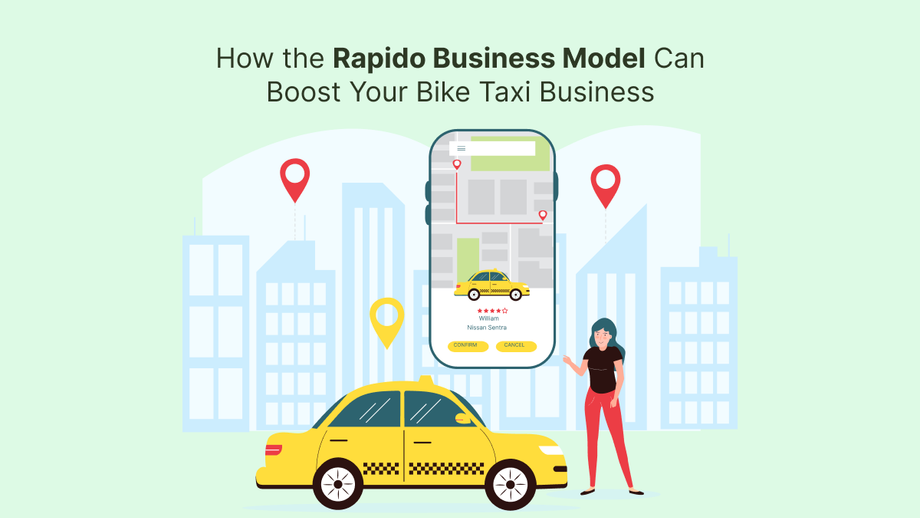Bike taxi services have become a preferred option for affordable and quick transportation in many cities across India. Among the leading players in this industry, Rapido has built a strong reputation and customer base with its innovative business approach. By focusing on affordability, scalability, and customer experience, Rapido has created a business model that many startups can learn from. If you are planning to start a bike taxi business, studying the Rapido business model can help you create strategies that improve growth and sustainability.
Understanding the Rapido Business Model
What is the Rapido Business Model
The Rapido business model revolves around connecting passengers with bike owners through a digital platform. Instead of owning vehicles, Rapido works with independent bike owners, called captains, who register on the platform and provide rides. The app handles booking, pricing, navigation, and payments, making the process smooth for both riders and passengers.
Why It Works in India
India’s congested cities, traffic challenges, and rising fuel prices have made two-wheelers an ideal solution. They are faster, cost less to maintain, and can easily navigate crowded streets. Rapido identified this gap in urban transport and positioned itself as an affordable and time-saving option.
Asset-Light and Scalable
Unlike traditional taxi services, Rapido does not invest in owning or maintaining a fleet of bikes. This asset-light model allows it to scale quickly across multiple cities with minimal infrastructure costs. The scalability of this business approach is one of its strongest advantages.
Revenue Streams in the Rapido Business Model
Commissions on Rides
Rapido earns revenue by charging captains a commission on each ride completed through the app. This ensures a steady flow of income as long as ride demand continues to grow.
Surge Pricing
When demand is high, fares increase due to surge pricing. This benefits both the company and captains, while still offering customers affordable rides compared to traditional options.
Subscriptions and Discounts
Rapido offers subscription packages for frequent riders. These plans provide lower fares for customers while ensuring recurring income for the business.
Delivery Partnerships
Rapido has expanded its business model to include delivery services for e-commerce, food, and local businesses. This diversification reduces dependency on passenger rides alone.
Corporate Solutions
Through partnerships with companies, Rapido offers employee transport and logistics services. These bulk deals bring stable revenue and strengthen B2B opportunities.
How Startups Can Learn from the Rapido Business Model
Identifying Market Gaps
Rapido succeeded by entering a segment that big ride-hailing companies were ignoring. Startups must analyze the market to find similar gaps where demand is high but supply is limited.
Read More: Rapido Business Model: How Rapido Harnesses the Power of Motorbikes
Leveraging Technology
The success of Rapido depends heavily on its mobile app. Startups should focus on building user-friendly apps with features like real-time tracking, easy payments, and quick booking.
Building an Asset-Light System
Owning vehicles increases cost and reduces flexibility. An asset-light model allows startups to scale quickly without high investments.
Focusing on Affordability
Pricing plays a key role in customer adoption. Affordable services attract larger audiences, especially in price-sensitive markets.
Adding Revenue Streams
Relying only on one income source is risky. Like Rapido, startups should diversify with delivery, corporate tie-ups, and subscription plans.
Operational Workflow of the Rapido Business Model
Booking a Ride
Customers open the app, enter their location and destination, view the fare estimate, and confirm the booking.
Assigning Riders
The app automatically matches the nearest available captain with the customer, ensuring quick service.
Ride and Payment
The rider picks up the passenger and completes the trip. Payments are processed digitally or in cash, depending on customer preference.
Post-Ride Feedback
Both customers and captains can rate each other, which helps maintain service quality and trust.
Challenges in the Rapido Business Model
Legal and Regulatory Issues
Bike taxi operations are not fully legalized in all regions. Startups must check and comply with transport laws before launching.
Competition
The mobility market is competitive, with players offering car, auto, and bike rides. Startups must focus on unique selling points to stand out.
Rider Retention
Captains must feel motivated to stay with the platform. Providing timely payments, incentives, and fair commissions is key to retaining them.

Customer Retention
Frequent discounts and loyalty rewards may be needed to ensure customers keep using the service.
Technology Management
A glitch-free app with continuous updates is essential to keep users satisfied.
Future of the Rapido Business Model in 2025
Rapido’s model is likely to expand beyond passenger rides to cover logistics, hyperlocal deliveries, and advanced subscription services. AI-driven features like smart route optimization and personalized offers will enhance customer experience. The demand for fast and affordable mobility options will only increase, making bike taxis a sustainable business choice.
Startups entering this market in 2025 should focus on advanced technology, reliable service, and multiple revenue sources to remain competitive.
Conclusion
The Rapido business model shows how affordability, scalability, and diversification can drive success in the bike taxi industry. For startups, it offers valuable lessons on how to design a profitable and sustainable business strategy. By focusing on customer needs, building strong partnerships, and investing in technology, entrepreneurs can grow in this competitive market. For those looking to expand beyond bike taxis, exploring solutions like gojek clone app can help in building multi-service platforms that offer even greater opportunities for growth.
FAQs
What is the Rapido business model?
The Rapido business model connects customers with bike owners through an app and earns revenue from commissions, surge pricing, and delivery services.
How does Rapido generate revenue?
Rapido earns money through ride commissions, surge pricing, subscriptions, delivery partnerships, and corporate solutions.
Why is the Rapido business model successful?
It is successful because it focuses on affordability, scalability, and diversification while solving the traffic and cost issues faced by urban commuters.
What challenges do bike taxi startups face?
Challenges include legal restrictions, rider retention, customer acquisition, and maintaining a high-quality mobile app.
Can startups replicate the Rapido model?
Yes, startups can replicate it by building an asset-light, scalable platform, focusing on affordability, and diversifying revenue sources.


